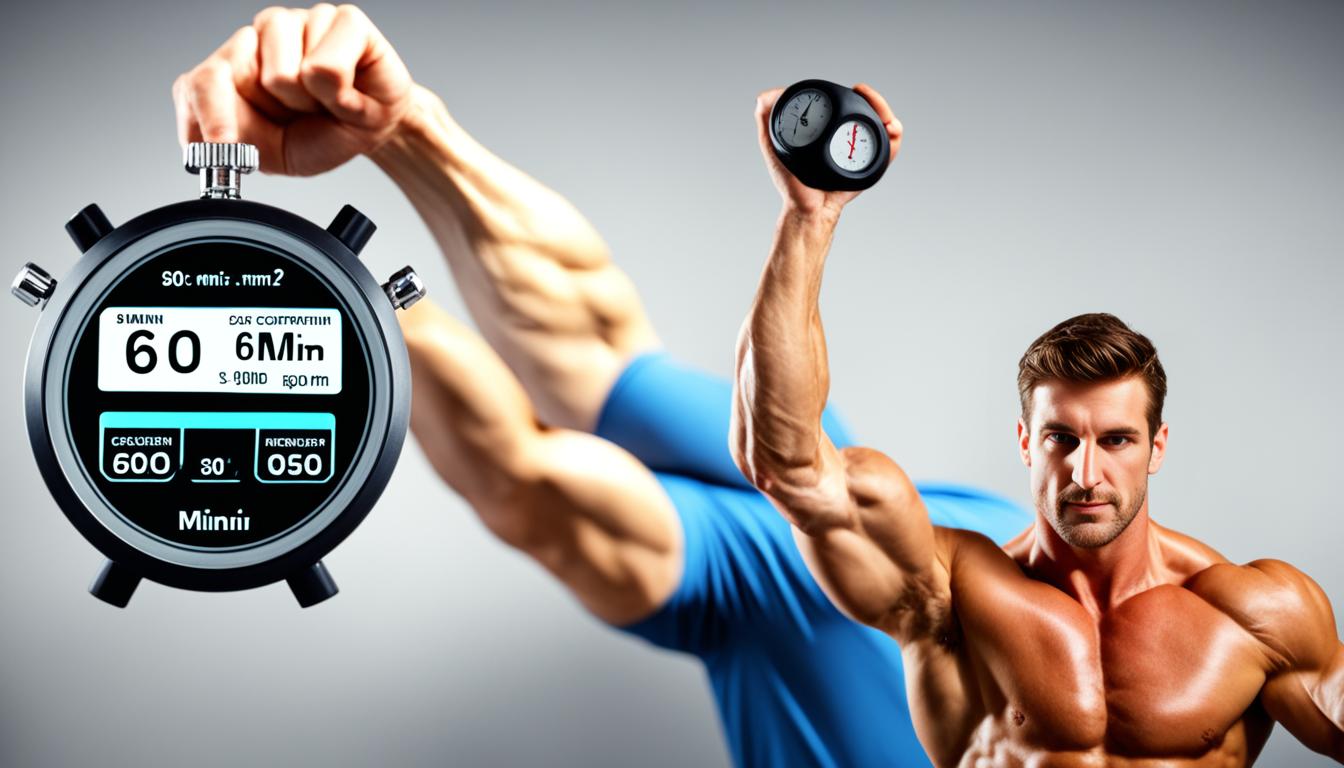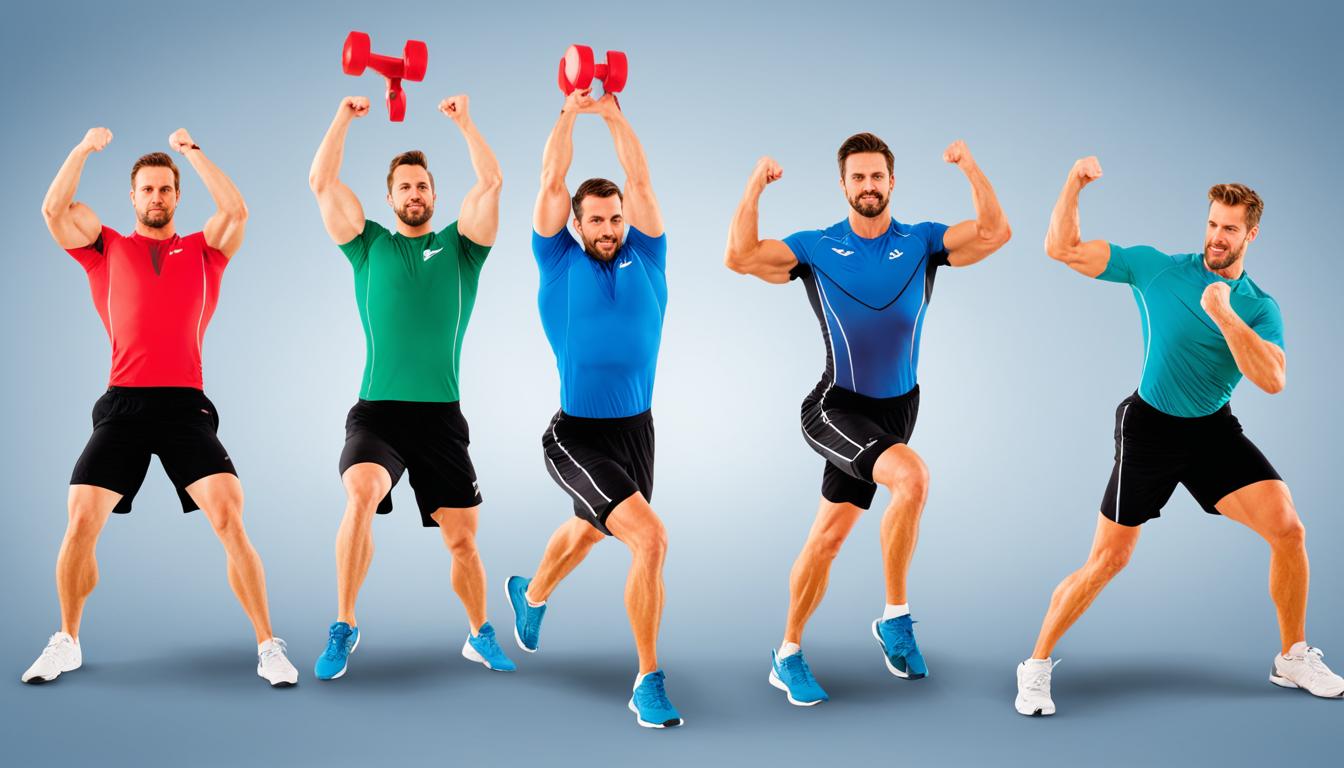Are you tired of common fitness myths holding you back from achieving your goals? It’s time to separate fact from fiction and debunk these misconceptions once and for all. With the help of factual data from various sources, we will shed light on some of the most prevalent fitness myths and provide the truth behind them.
Key Takeaways:
- Don’t believe the myth that spending more time at the gym leads to better results. Focus on quality workouts and using your time efficiently.
- Sustainable habits are key to long-term success. Gradual changes and achievable goals are more effective than drastic transformations.
- Weight loss is not solely dependent on cardio. Incorporate weight training for the afterburn effect and increased metabolism.
- Crunches are not the only exercise for abs. Focus on overall core strength for stability, balance, and injury prevention.
- The Big Six movements are essential for building strength and improving overall fitness. They are accessible to individuals of all fitness levels.
The Longer the Workout the Better the Result?
Contrary to popular belief, spending more time at the gym does not always lead to better results. The key to effective workouts lies in quality rather than quantity. Prolonged workouts may not be as effective if you’re not maximizing your time and effort.
It’s important to assess your own gym schedule and make sure you’re using your time efficiently. By prioritizing effective sessions, proper rest times, and optimizing your workout routine, you can achieve better results in less time.
When it comes to workout duration, it’s crucial to understand that everyone’s body is different and what works for one person may not work for another. The key is to find a balance that works for you personally.
Remember, it’s not about how long you spend at the gym, but what you do with that time. By focusing on the effectiveness of workouts rather than the duration, you can maximize your results and make the most out of your time at the gym.

Big Huge Changes are All That Matters?
When it comes to starting a fitness journey, it’s easy to get caught up in the idea that only big, drastic changes can lead to real results. However, the truth is that sustainable habits are the key to achieving long-term success in your fitness goals. Instead of overwhelming yourself with numerous changes at once, it’s important to focus on making gradual, achievable adjustments that can be maintained over time. By taking a thoughtful and measured approach, you can lay the foundation for lasting health and fitness.
Implementing small, sustainable changes allows you to develop new habits that become deeply ingrained in your daily routine. Rather than attempting drastic and unsustainable transformations, choose one or two specific goals that you can realistically achieve. For example, start by committing to incorporating more vegetables into your meals or making time for a short workout each day. By consistently practicing these small changes, they will eventually become second nature and form the building blocks of a healthier lifestyle.

“It’s about progress, not perfection.”
Adopting a gradual approach to fitness allows you to prioritize the development of sustainable habits over short-term results. While it can be tempting to seek instant transformation, real progress takes time. By focusing on gradual changes, you can build a strong foundation and set yourself up for long-term success.
Not only do sustainable fitness habits support long-term results, but they also promote a positive and balanced approach to overall well-being. By making gradual changes, you can avoid the burnout and frustration that often accompanies drastic transformations. Instead, you can create a sustainable and enjoyable fitness journey that brings lasting changes to your health and happiness.
Embrace the Power of Consistency
Consistency is the key to achieving sustainable fitness habits and long-term results. Rather than aiming for perfection or quick fixes, focus on showing up consistently and giving your best effort. Remember, every small step you take towards your goals contributes to your overall progress.
By taking a gradual approach and implementing sustainable habits, you are setting yourself up for success. It’s not about the big changes; it’s about the small, consistent actions that add up over time to create real and lasting transformation. So, embrace the power of sustainable habits and commit to making gradual changes that will lead to long-term results.
Cardio is the Only Way to Lose Weight?
When it comes to weight loss, many people believe that cardio exercises are the only effective way to shed those extra pounds. While cardio certainly plays a significant role in weight loss, it’s important to understand that any form of movement that expends energy can contribute to your weight loss journey.
The key to losing weight is the simple equation of calories in versus calories out. This means that you need to burn more calories than you consume in order to create a calorie deficit, which leads to weight loss. Cardio exercises, such as running, cycling, or swimming, are great for burning calories and increasing your heart rate.
However, weight training also has its own unique benefits when it comes to weight loss. Weight training helps to increase muscle mass, and muscles are more metabolically active compared to fat. This means that building lean muscle through weight training can boost your metabolism and calorie burn even after your workout is over. This phenomenon is known as the afterburn effect.
So, don’t fall into the misconception that weight loss is solely dependent on cardio exercises. A balanced exercise routine that combines both cardio and weight training can be highly effective for weight loss. By incorporating weight training into your workouts, you not only burn calories during the session but also increase your metabolic rate and calorie burn throughout the day.
Remember, the most important factor in weight loss is creating a calorie deficit. Whether you achieve this through cardio exercises, weight training, or a combination of both, the key is consistency and finding a routine that works for you.
“Weight loss is not solely dependent on cardio. Building lean muscle through weight training can boost your metabolism and calorie burn even after the workout.”

Weight loss is a journey that requires dedication and a holistic approach. By incorporating both cardio and weight training into your fitness routine, you can maximize your calorie burn and achieve your weight loss goals. So lace up your running shoes, grab those dumbbells, and get ready to crush your workouts!
Crunches are Best for Abs?
Many people believe that crunches are the best exercise for sculpting six-pack abs. However, the truth is that abs are just one part of the core. Core strength encompasses more than just the appearance of abs. A strong core helps with overall stability, balance, and injury prevention. While it’s okay to have aesthetic goals, it’s important to focus on functional strength and overall core development. By incorporating exercises that target the entire core and focusing on overall core strength, you can achieve a strong and functional core.

The Big Six Movements for Strength and Well-being
The Big Six movements, consisting of the barbell back squat, deadlift, bench press, overhead press, chin-up, and dip, are powerful compound exercises that engage multiple muscle groups simultaneously. These movements are not only highly effective for building strength but also have a range of benefits that positively impact your overall fitness and well-being.
Compound exercises like the Big Six movements are known for their ability to target multiple muscles in a single movement, making them efficient and time-saving. By incorporating these fundamental exercises into your strength training routine, you can maximize your workout and achieve optimal results.
One of the key benefits of the Big Six movements is their ability to develop functional strength. Unlike isolation exercises that focus on specific muscles, compound exercises simulate movements used in real-life activities, helping you build strength that translates into your daily life. Whether you’re lifting groceries, playing sports, or carrying out household tasks, the strength gained from these movements will make these activities easier and less prone to injury.
Moreover, the Big Six movements promote muscle balance and coordination. By engaging multiple muscle groups, they help improve overall body symmetry and coordination, enhancing your physical performance in various activities. This balanced development not only improves your aesthetics but also boosts your functional abilities.
Strength training with compound exercises also leads to an increase in bone density, reducing the risk of osteoporosis and fractures as you age. The stress placed on your bones during these movements stimulates bone remodeling, resulting in stronger and denser bones.
Additionally, the Big Six movements stimulate the release of growth hormone and testosterone, two key hormones for muscle growth and repair. This hormonal response not only helps you build lean muscle mass but also accelerates fat loss, as muscle tissue is metabolically active and burns more calories throughout the day.
To gain the maximum benefits from the Big Six movements, it’s important to prioritize proper form and technique. Start with lighter weights and focus on mastering the movements before gradually increasing the load. Always warm up adequately before attempting these exercises to prevent injury.
By incorporating the Big Six movements into your strength training routine, you can establish a solid foundation of strength and well-being that positively impacts all aspects of your life. Whether your goal is to build muscle, improve performance, or increase overall fitness, these compound exercises are essential for achieving optimal results.

Debunking Myths about the Big Six Movements
When it comes to the Big Six movements, there are several misconceptions that need to be addressed. One common myth is that these movements are only suitable for experienced athletes or bodybuilders. However, the truth is that the Big Six movements can be adapted to accommodate individuals of all fitness levels. Whether you’re a beginner or a seasoned fitness enthusiast, these movements can be tailored to your abilities and goals.
Another prevalent misconception is that expensive equipment is required to perform the Big Six movements. In reality, all you need is basic equipment like a barbell and weight plates to get started. You don’t need fancy machines or elaborate setups to reap the benefits of these movements. With a simple setup and proper technique, you can incorporate the Big Six movements into your fitness routine without breaking the bank.
It’s essential to understand that the Big Six movements offer a wide range of benefits beyond just building muscle mass. While they are effective for strength gains and muscle development, these movements also enhance overall mobility, stability, and fitness. They engage multiple muscle groups simultaneously, providing a comprehensive workout that translates into real-life movements and activities. By incorporating the Big Six movements into your fitness routine, you can improve your physical capabilities and enhance your overall well-being.
Don’t let the misconceptions hold you back from embracing the Big Six movements. Regardless of your fitness goals or current fitness level, these movements are accessible to everyone. They can be modified to meet your individual needs and capabilities, ensuring that you can safely and effectively incorporate them into your workout routine. So, don’t be afraid to give them a try and experience the incredible benefits they have to offer.

Conclusion
Now that you have debunked common fitness myths and separated fitness fiction from the truth, you are equipped with the knowledge to make informed decisions about your fitness journey. It is essential to focus on factual information and avoid falling prey to misconceptions that could hinder your progress.
Remember, it’s not just about the quantity of your workouts, but the quality. By prioritizing effective sessions and optimizing your routine, you can achieve better results in less time. Additionally, implementing sustainable habits and making gradual changes will lead to long-term success and allow you to maintain a healthy lifestyle.
When it comes to weight loss, understand that cardio is not the only solution. Incorporate both cardio and weight training into your exercise routine to maximize calorie burn and boost metabolism. Similarly, while crunches have their place in targeting abs, focus on overall core strength and functionality to achieve a strong and stable core.
By embracing the Big Six movements and understanding that they are accessible to all fitness levels, you can build strength, improve mobility, and enhance overall fitness. These compound exercises lay the foundation for a well-rounded fitness regimen.
So go ahead, armed with the facts and truth, embark on your fitness journey with confidence and achieve your fitness goals.
FAQ
Is spending more time at the gym always better for results?
No, the key to effective workouts lies in quality rather than quantity. It’s important to prioritize effective sessions, proper rest times, and optimizing your workout routine to achieve better results in less time.
Do I need to make multiple drastic changes to see results?
No, sustainable habits are key to long-term success. Focus on one or two small, achievable goals at a time and allow these changes to become ingrained habits before moving on to the next ones.
Is cardio the only way to lose weight?
No, any form of movement that expends energy can assist in weight loss. While cardio does help, weight training offers the advantage of increasing muscle mass, boosting metabolism, and calorie burn even after the workout. Incorporate a balanced exercise routine that includes both cardio and weight training.
Are crunches the best exercise for abs?
No, core strength encompasses more than just abs. Focus on overall core development and functional strength. Incorporate exercises that target the entire core to achieve a strong and functional core.
What are the Big Six movements?
The Big Six movements consist of the barbell back squat, deadlift, bench press, overhead press, chin-up, and dip. These compound exercises engage multiple muscle groups simultaneously, making them highly effective for building strength and improving overall fitness.
Are the Big Six movements only for experienced athletes or bodybuilders?
No, the Big Six movements can be adapted to suit individuals of all fitness levels. They can be performed with basic equipment like a barbell and weight plates.
What are the benefits of the Big Six movements?
The Big Six movements not only help build muscle mass but also enhance strength, mobility, and overall fitness. They are accessible to everyone, regardless of their fitness goals.
Source Links
- https://www.mikaeladiblasio.com/blog/busting-fitness-myths
- https://www.mdanderson.org/publications/focused-on-health/exercise-myths.h12-1589046.html
- https://www.haaretz.com/haaretz-labels/2023-08-07/ty-article-labels/.premium/busting-fitness-myths-and-unlocking-strength-and-health/00000189-cfdf-d9f3-a1cd-ffdf6e070000


